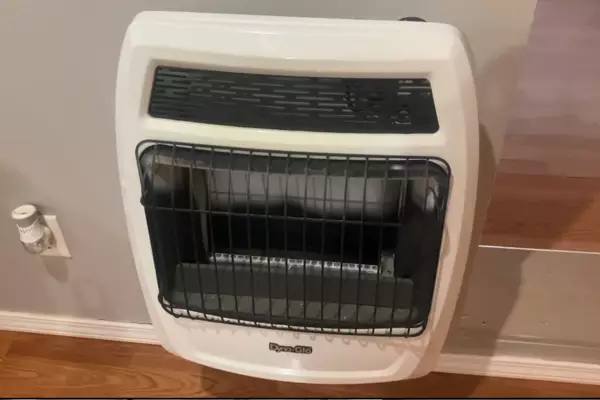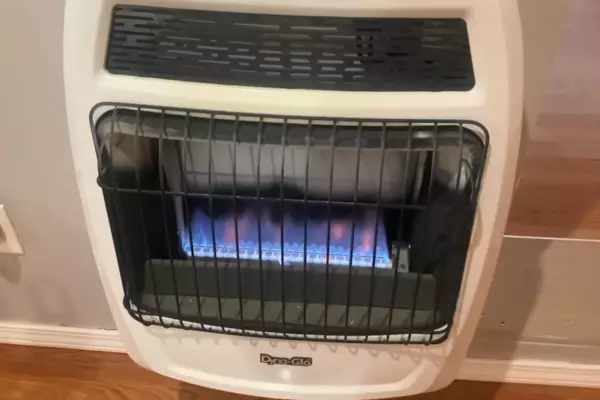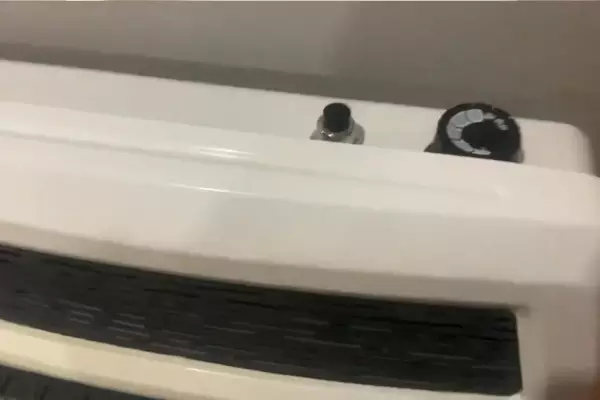There’s nothing quite like the comfort of a warm room during a chilly season. For many homeowners and renters, gas wall heaters with electronic pilots are a key component in achieving this comfort. These units are renowned for their efficiency and ease of use.
An electronic pilot light simplifies the operation of gas wall heaters. Essentially, it’s a miniature gas burner that stays lit continuously, ensuring your heater is ready to start at any moment. Operating a gas wall heater safely and correctly involves understanding the electronic pilot and its functionality.
Gas wall heaters are commonplace, but their operation isn’t always common knowledge. This article aims to provide you with the knowledge needed to operate your gas wall heater confidently and safely. Let’s get into it.
Contents
Gas Heaters and Electronic Pilots
Gas wall heaters, designed to efficiently warm up a single room or a small house, rely on either natural gas or propane to generate heat. These appliances have proven to be economical and energy-efficient alternatives to central heating systems, especially in milder winter climates.
Features of Gas Wall Heaters
One of the main features that make gas wall heaters an attractive choice is their direct heating capability. Rather than circulating heated air through ducts, gas wall heaters directly warm the air in the room they are installed in, thus reducing energy loss. This direct heating method often leads to a quicker and more efficient heating experience.
The heaters typically have a built-in thermostat that allows users to adjust and maintain a comfortable room temperature. Most modern gas heaters are equipped with a fan that helps distribute the heat more evenly around the room.
Furthermore, gas wall heaters are generally compact and designed to fit into small spaces, which makes them ideal for apartments, studios, or houses with limited space. They are also known for their quiet operation, adding to the overall comfort.

Electronic Pilot: A Brief Overview
An electronic pilot light is a feature of many modern gas heaters that provides a safe and efficient method of igniting the burner. Unlike traditional standing pilot lights that burn continuously, an electronic pilot light generates a spark to ignite the gas only when the heater is turned on.
This feature enhances the safety of gas wall heaters. The chance of gas leakage is reduced as the pilot light is not continuously burning. Plus, it increases energy efficiency as gas is not wasted on keeping a pilot light burning when the heater is not in use.
Preparation Steps
Before you attempt to light your gas wall heater, it is essential to take some preliminary steps to ensure your safety and the correct operation of the heater.
Safety Measures Before Lighting the Heater
Safety should always be a top priority when dealing with appliances that use gas. The following are some basic safety measures you should take:
- Clear the area: Make sure the area around the heater is free of any flammable materials such as furniture, curtains, and rugs. This will help to prevent any accidental fires.
- Ventilation: Check that the room is well ventilated. Adequate ventilation is necessary to prevent the buildup of carbon monoxide, a harmful byproduct of burning gas.
- Gas smell: Be alert for the smell of gas before you begin. If you smell gas, do not attempt to light the heater. Instead, turn off the gas supply, evacuate the house, and call your gas company immediately.
How to Check Gas Supply
Before you light the heater, it’s important to make sure that gas is being supplied to it.
- For natural gas heaters: Check that the gas valve connected to the heater is in the open position. You can usually find this valve near your gas meter.
- For propane heaters: Make sure there’s enough propane in your tank. Many tanks have a gauge that shows the level of propane left in the tank.
If the gas supply appears to be in order but the heater still doesn’t light, there may be an issue with the gas line or the heater itself. In this case, you should contact a professional.

How to Turn on Gas Heater on Wall
Once you’ve taken the necessary safety measures and confirmed the gas supply, you can proceed to turn on your gas heater.
Switch On: Step by Step Guide
Here are the steps to ignite a gas wall heater equipped with an electronic pilot:
- Open the control panel: Most heaters have a small door or panel that covers the control knob and ignition button. Open this to access the controls.
- Set to ‘Pilot’: Turn the control knob to the ‘Pilot’ position. This prepares the heater to ignite the pilot light.
- Ignite: Push the ignition button, which creates a spark at the pilot assembly.
Remember, the control knob must be turned to the ‘Pilot’ position before igniting. Igniting without setting to ‘Pilot’ may result in incomplete combustion, leading to a sooty flame and potential hazards.
Common Mistakes to Avoid
It’s important to avoid certain common mistakes to ensure the safe and effective operation of your gas wall heater.
- Avoid forcing the control knob. Applying too much pressure can damage the knob or the internal components it’s connected to. Instead, use steady, gentle pressure.
- Don’t ignore the ventilation. Good ventilation is not just necessary during the operation of the heater but also when igniting it. An unventilated room can lead to the accumulation of unburnt gas, causing potential health risks.
Best Wall Mounted Gas Heater
Dreo Radiator 1500W Electric Portable Space Oil Filled Heater
- Warm Heating for Whole Room: 1500W high power, spindle-shaped openings and M-shaped heating fins...
- Feel Heat Faster: The spindle-shaped openings, 225 mm larger than others enlarged fins and Dual U-shaped heating tubes...
- Cool Touch Design: With the wraparound heating fins design, the heating element and fins are not directly exposed, preventing burn risks...
Mr. Heater 30,000 BTU Blue Flame Natural Gas Heater
- 30,000 BTU Natural Gas heater to heat spaces up to 1000 square feet
- Blue flame burner for even convection heat. Maximum Elevation (Ft)-4500. Fuel Consumption/Burn Rate (Gal/Hr)- .030 MCF
- Automatic low oxygen shut-off system (ODS). CSA Certified. Heater Type: Unvented
How to Light a Gas Wall Heater
With the control knob in the ‘Pilot’ position and the heater ready to ignite, you can now proceed to light the heater.
Engaging the Electronic Pilot
While holding the control knob in, press the ignition button. You should hear a clicking sound, which is the sound of the ignition spark being generated. If your heater has a viewing port, you can look through it to confirm the spark at the pilot assembly.
Lighting Process Explained
Once the spark has been generated, the pilot light should ignite if your gas supply is active. If you see a steady blue flame, this indicates that the pilot light is burning correctly.
Next, turn the control knob from the ‘Pilot’ position to the ‘On’ position. This allows gas to flow to the main burner, which should ignite from the flame of the pilot light. Now, your gas wall heater is successfully lit and ready to heat your space.

After the Heater is Lit
With your gas heater now lit, there are a few additional steps to ensure its proper operation.
Verifying Successful Ignition
After lighting the heater, make sure that the main burner has ignited. The sound of the burner is typically a low, steady roar, and you may also notice that the heater starts to warm up.
Proper Adjustment of Heater Controls
Adjust the thermostat to the desired temperature. For the best results, avoid setting the temperature too high. It may overwork the heater, leading to decreased efficiency and potential damage.
Daily Operation Tips
Optimal Heater Usage Practices
- Ensure regular maintenance of the heater.
- Keep the heater’s vent unobstructed for proper heat circulation.
- Avoid setting the temperature too high.
Ensuring Heater Longevity
Regular maintenance and careful operation are key to ensuring your heater’s longevity. Check for potential issues regularly, and if you detect any, consult a professional for repair.
How to Turn off a Gas Wall Heater
Steps for Safe Heater Shut Down
- Turn the control knob to the ‘Off’ position.
- Ensure the pilot light and the burner are both extinguished.
Tips on Heater Maintenance
Keep the area around the heater clean and free of flammable materials. Regularly inspect for any signs of wear or damage. Arrange for professional maintenance annually.
In Case of Emergencies
Troubleshooting Common Issues
If your pilot light won’t stay lit or the heater isn’t producing enough heat, the issue could be a dirty pilot tube or an improperly set thermostat. If you’re not comfortable addressing these issues yourself, call a professional.
When to Seek Professional Help
Seek professional help if you detect a gas leak, the heater isn’t functioning even after troubleshooting, or the heater is due for its annual maintenance.
Frequently Asked Questions
Why Won’t My Gas Heater Ignite?
A gas heater may fail to ignite due to a few reasons like a faulty pilot light, an issue with the gas supply, or a problem with the ignition system. Always seek professional help in such cases to avoid safety risks.
How Often Should I Service My Gas Wall Heater?
It’s recommended to get your gas wall heater serviced at least once a year by a licensed professional to ensure its safe and efficient operation.
Is It Normal for the Pilot Light to Always Stay On?
In traditional gas heaters, the pilot light stays on continuously. But modern heaters with electronic pilots ignite only when the heater is in use, saving energy and increasing safety.
Conclusion
Gas wall heaters, equipped with electronic pilots, offer a cost-effective way to heat your space. However, understanding their operation is crucial for safety and efficiency.
To operate a gas wall heater, one must follow the correct procedures, such as preparing by checking the gas supply and ensuring safety measures. Lighting the heater involves engaging the electronic pilot and adjusting the controls accordingly.
With careful operation and regular maintenance, gas wall heaters can serve your heating needs efficiently for years. It’s always essential to consult a professional when in doubt, to ensure safety and longevity of the heater.



